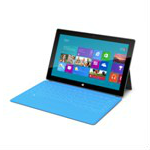 Consumer interest in and purchases of tablets waned in 1Q 2016, according to preliminary market data from IDC. But detachable tablet shipments saw a substantial increase, climbing to 4.9 million units worldwide. That’s triple the units sold in the same quarter of 2015.
Consumer interest in and purchases of tablets waned in 1Q 2016, according to preliminary market data from IDC. But detachable tablet shipments saw a substantial increase, climbing to 4.9 million units worldwide. That’s triple the units sold in the same quarter of 2015.
Worldwide tablet shipments dropped 14.7% year-over-year to 39.6 million units due to seasonal factors and a ¨disinterested customer base,¨ IDC highlights in a press release.
Conventional slate tablet shipments accounted for 87.6% of total 1Q’16 shipments, but that percentage is declining. More significantly in terms of long-term market evolution, slate tablets are now considered the low-end of the product category, IDC says.
That bodes well for vendors such as Amazon, whose Kindle Fire is among the least expensive tablets on the market. Amazon may be able to afford to undercut competitors on price and make up revenues via online retail sales of other products. Other OEMs don’t have that option and need higher margin tablet sales to sustain their businesses, IDC notes.
Detachable Tablet Shipments
Detachable tablet shipments are likely to remain strong, IDC suggests.
“Microsoft arguably created the market for detachable tablets with the launch of their Surface line of products,” said Jitesh Ubrani, senior research analyst with IDC’s Worldwide Quarterly Mobile Device Trackers, in IDC’s press release. The PC industry’s decline could help drive detachable tablet shipments as consumers and enterprises seek to replace their aging PCs with detachables, Ubrani noted.
“Apple’s recent foray into this segment has garnered them an impressive lead in the short term, although continued long-term success may prove challenging as a higher entry price point staves off consumers and iOS has yet to prove its enterprise-readiness, leaving plenty of room for Microsoft and their hardware partners to reestablish themselves.”
Samsung and Huawei launched detachable tablets in 1Q amidst shrinking margins for slate tablets. Mid-range in price, Samsung’s and Huawei’s detachable tablets will find it difficult to gain traction, according to IDC. Performance-conscious customers are likely to opt for premium offerings, such as Microsoft’s Surface, while budget-conscious buyers are likely to opt for low-end models, such as offerings from EFun, RCS or others.
IDC’s research director for tablets Jean Philippe Bouchard pointed out the threat the detachable tablets that smartphone vendors are offering pose to PC manufacturers. “Their understanding of the mobile ecosystem and the volume achieved on their smartphone product lines will allow them to aggressively compete for this new computing segment,¨ Bouchard was quoted.
¨It is likely that those smartphone vendors will utilize the detachable segment to create new mobile computing end-user experiences if customers are using their detachables in combination with their smartphones.”
OEM Trends
IDC also highlights 1Q’16 developments among the top 5 tablet OEMs in its latest report:
- Apple’s dominance in the overall market is unsurprising. iPad’s future will be largely relegated to replacements – of older iPads or PCs—rather than net new additions. The latest iPad Pro 9.7″ and more enterprise friendly storage options for the slightly older iPad Pro 12.9″ are healthy additions to the iPad lineup. The recent price drop on the iPad Air 2 should help sway those who were previously undecided to upgrade their older iPad 2s.
- Samsung’s Galaxy Tab lineup continues to do well and is one of the last remaining “premium” Android tablets. The launch of the detachable TabPro S has been somewhat tepid due to the high price point, though this is likely a short-term hiccup as Samsung is typically quick to offer various products and different price points.
- Amazon’s low-cost Fire tablet is certainly not the first of its kind, but its success speaks to Amazon’s prowess as a household brand and a distribution powerhouse. Though the year-over-year growth is an astronomical 5421.7%, it is important to note that Amazon’s 1Q15 lineup featured a 6″ tablet which was not counted by IDC as it did not meet the requirements of IDC’s taxonomy.
- Lenovo continues to suffer from slowing demand for Android slate tablets. While Lenovo has introduced some detachables and increased its Windows 10 portfolio, there are still gaps in its lineup in terms of performance and price points. IDC believes those gaps will soon be filled, allowing Lenovo to benefit from growth in detachable tablet shipments.
- Huawei rounds out the top 5 with a vast majority of its shipments falling in the slate tablet category. Huawei’s introduction in February of its first detachable, the MateBook, will help it build momentum in the next quarter of 2016. The impressive growth recorded by Huawei is a clear indication of its resource allocation and optimization of its carrier relationships as a channel for its portfolio.

